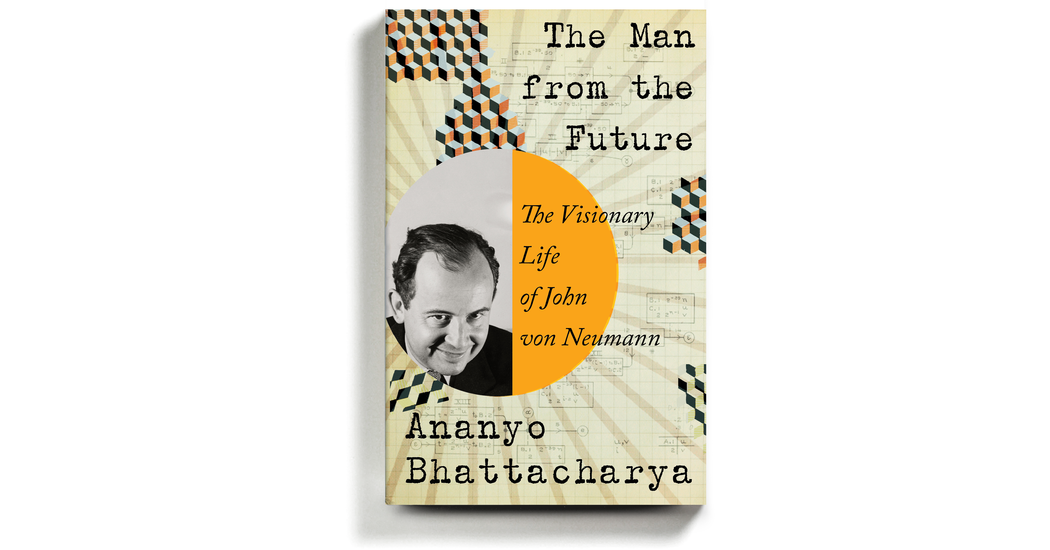
THE MAN FROM THE FUTURE
The Visionary Life of John von Neumann
By Ananyo Bhattacharya
Illustrated. 353 pages. W.W. Norton & Company. $30.
The mathematician John von Neumann was an undeniable genius whose many accomplishments included an essential role in the development of quantum mechanics, computing and the atom bomb. As the co-author of one of the first textbooks on game theory, he took a coolly analytical approach to a range of situations that included bluffing in poker and the prospect of nuclear annihilation. Still, von Neumann didn’t let his deep understanding of physics and rational utility get in the way of something else that was clearly very important to him: a love of driving, along with what seemed to be a cheerful commitment to being terrible at it.
After leaving Europe in 1933 for a life of the mind at the Institute for Advanced Study in Princeton, N.J., von Neumann failed the driving test so many times that he had to bribe the examiner to get his license. Every year he found an excuse to buy a new car, preferably an enormous Cadillac. “I was proceeding down the road,” he would start to say to his incredulous friends when recalling another one of his accidents. “The trees on the right were passing me in orderly fashion at 60 miles an hour. Suddenly one of them stepped in my path. Boom!”
This is one of several vivid anecdotes recounted in Ananyo Bhattacharya’s “The Man From the Future,” which bills itself as a biography of von Neumann but is more devoted to exploring the ideas and technological inquiries he inspired.
“The mathematical contributions von Neumann made in the mid-20th century now appear more eerily prescient with every passing year,” Bhattacharya writes, alluding to this book’s excellent title. “His thinking is so pertinent to the challenges we face today that it is tempting to wonder if he was a time traveler, quietly seeding ideas that he knew would be needed to shape the Earth’s future.”
When von Neumann was alive, before the full import of his influence could be gauged, his brilliance marked him not as a time traveler but as an alien — one of the so-called Martians, the nickname for the Hungarian-Jewish emigrés, including Edward Teller, who worked on the secret atom bomb project at Los Alamos. Naturally, the intellectually omnivorous von Neumann came up with his own theories about the “Hungarian phenomenon” (the shorthand term for the scientific accomplishments of von Neumann and his countrymen), deciding that it had something to do with the Austro-Hungarian mixture of liberalism and feudalism that allowed Jews some avenues for success while keeping them away from the true levers of power. This provoked “a feeling of extreme insecurity,” von Neumann said, making him and his fellow Martians believe that they needed “to produce the unusual or face extinction.”
This was a dark and introspective assessment from someone who may have anticipated World War II in Europe but was also remembered as “a cheerful man, an optimist who loved money and believed firmly in human progress,” in the words of one of his lifelong friends. Bhattacharya, a science journalist who also holds a Ph.D. in physics, doesn’t probe too deeply into these apparent contradictions. We get a brisk tour through the first three decades of von Neumann’s life — born in Budapest in 1903, he was a mathematical prodigy who lived a mostly privileged existence — before we land in Princeton, where his real-world influence quickly took off.
Von Neumann came of age when mathematics wasn’t considered a “practical” profession. He studied chemistry too, as a sop to his father, an investment banker — banking being another field that, later on, would become in thrall to mathematics. After arriving in the United States, von Neumann spent nearly a quarter of a century at the Institute for Advanced Study, where his office neighbors included Albert Einstein and Kurt Gödel. From New Jersey von Neumann would travel the country, teaching and consulting, most consequentially at Los Alamos. Bhattacharya quotes from a report that von Neumann put together for the U.S. Navy, detailing how the “angle of incidence” could make a bomb’s detonation more destructive. The report may have been written for a military audience, but von Neumann seems so excited by his own reasoning that he resorts to exclamation points.
Bhattacharya shows how this unabashedly forthright treatment of “morally fraught matters” earned von Neumann a reputation for hawkishness, as did his support for the logic of “preventive war.” He advocated taking out the Soviet Union’s nuclear arsenal with a surprise attack (“If you say why not bomb them tomorrow, I say why not today?”) — a position that he later walked back. Yet Bhattacharya also says that von Neumann, as someone who was “Central European to the core,” believed that people would work together for their mutual benefit, which was embedded in his approach to game theory. So who was he? The hopeful Central European or the hard-nosed cold warrior?
He was, as Bhattacharya puts it, “a complex character,” and there are tantalizing glimmers of such human strangeness and complexity in this book. But “The Man From the Future” sometimes seems so focused on explicating that future — narrating the fates of von Neumann’s ideas long past his death, from cancer, in 1957 — that the man himself recedes from view.
The skill with which Bhattacharya teases apart dense scientific concepts left me feeling ambivalent. On the one hand, what we do see of von Neumann hints at such a fascinating personality that I wanted to know more; on the other, maybe there’s something to be said for fixating so intently on the cerebral output of someone whose daughter once observed, “My father’s first love in life was thinking.”
Besides, von Neumann, ever the restless pollinator, may have approved of his biographer’s approach: “Busy with so many other things, he would whizz in, lecture for an hour or two on the links between information and entropy or circuits for logical reasoning, then whizz off again — leaving the bewildered attendees to discuss the implications of whatever he had said for the rest of the afternoon.”




